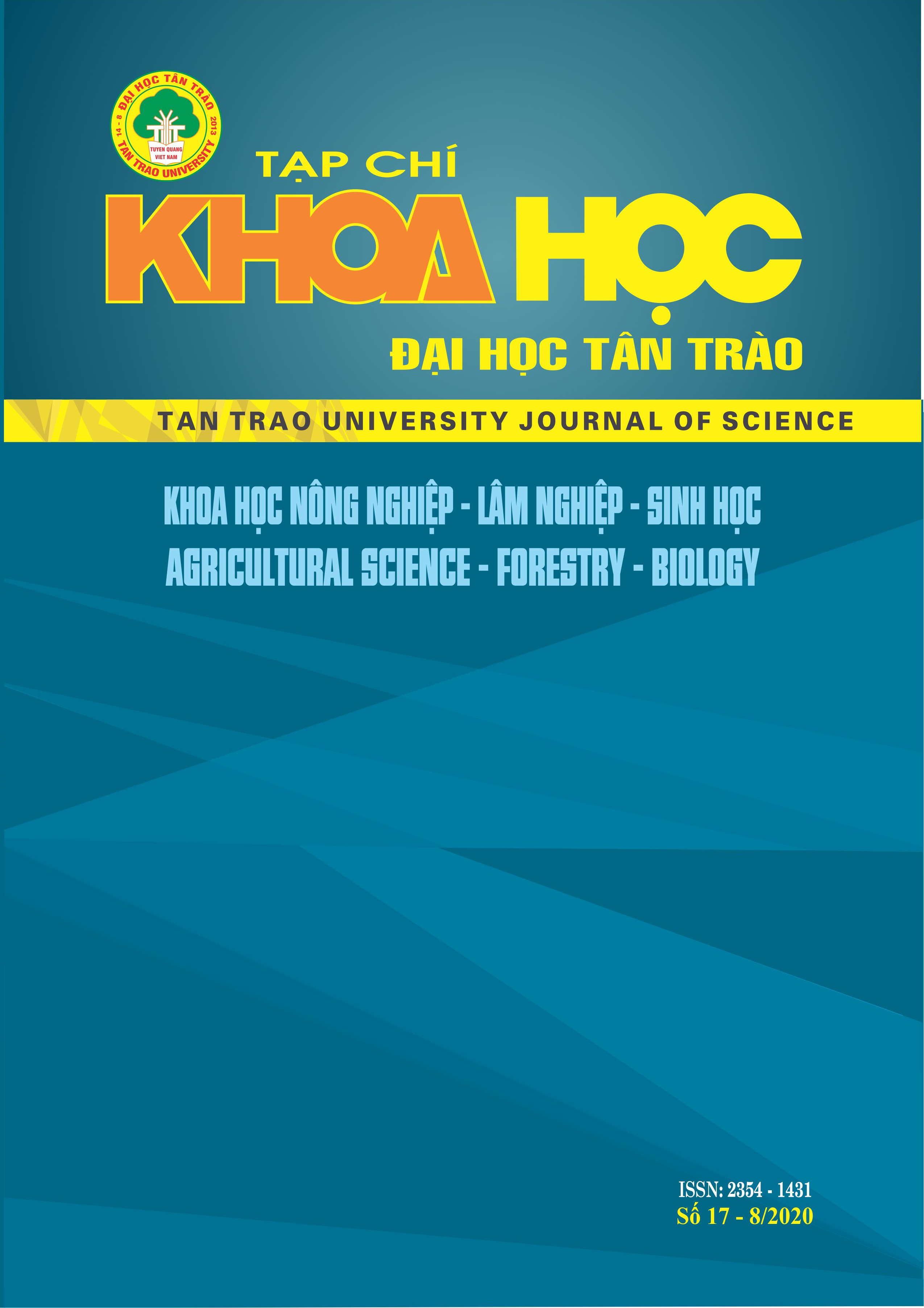NGHIÊN CỨU CÁC YẾU TỐ ẢNH HƯỞNG ĐẾN QUÁ TRÌNH TÁCH CHIẾT SAPONIN TỪ HẠT CHÔM CHÔM
DOI:
https://doi.org/10.51453/2354-1431/2020/386Từ khóa:
Hạt chôm chôm, saponin, trÃch ly, dung môi, nguyên liệuTóm tắt
Mục tiêu của nghiên cứu này là nghiên cứu khảo sát một số yếu tố ảnh hưởng đến quá trình tách chiết saponin từ hạt chôm chôm bao gồm: kích thước nguyên liệu, nồng độ dung môi (ethanol), tỷ lệ nguyên liệu/ dung môi và thời gian tách chiết. Hạt chôm chôm được mua từ chợ Túc Duyên Thành phố Thái Nguyên. Hạt sau khi được tách ra khỏi thịt quả được bóc vỏ và làm khô đến độ ẩm khoảng 8% để dùng cho các thí nghiệm. Kết quả cho thấy kích thước nguyên liệu phù hợp là 1,2 mm, nồng độ dung môi trích ly tốt nhất là 70%, tỷ lệ dung môi chiết là: 250ml/5g nguyên liệu và thời gian trích ly là 3 giờ cho hiệu quả chiết saponin cao nhất.
Tải xuống
Tài liệu tham khảo
1. Chan, K. W., Khong, N. M. H., Iqbal, S., & Ismail, M. (2013). Isolation and antioxidative properties of phenolics-saponins rich fraction from defatted rice bran. Journal of Cereal Science, 57, pp. 480-485
2. Cheok, C.Y., H.A.K. Salman and R. Sulaiman.
, Extraction and quantification of saponins: a review. Food Research International 59: pp. 16-40.
3. Goel, N., Sirohi, S. K., & Dwivedi, J, (2012), Estimation of total saponins and evaluate their effect on in vitro methanogenesis and rumen fermentation pattern in wheat straw based diet, Journal of Advanced Veterinary Research, 2, 120-126
4. Sheng, H., & Sun, H. (2011), Synthesis, biology and clinical significance of pentacyclic triterpenes: A multi-target approach to prevention and treatment of metabolic and vascular diseases, Natural Product Reports, 28, pp. 543-593.
5. Sparg, S. G., Light, M. E., & van Staden, J, (2004), Biological activities and distribution of plant saponins, Journal of Ethnopharmacology, 94, pp. 219-243
6. Tran Van Hau and Chau Trung Duong (2006). Some biological characteristics of the flowering of the Javan tree rambutans are cultivated in Can Tho. Journal of Scientific Research Can Tho University ( vol.6): p. 53-59.
7. Nguyen Minh Thuy, Nguyen Thi Thu Hong, Nguyen Phu Cuong, Nguyen Thi My Tuyen, Duong Kim Thanh1 and Ho Thanh Huong (2013), Changing the physical, chemical properties and sensory properties of the Java rambutan tree din the process of domestication and storage. Scientific Journal of Can Tho University (vol. 28): p. 28 -35.
8. Verza, S. G., Silveira, F., Cibulski, S., Kaiser, S., Ferreira, F., Gosmann, (2012), Immunoadjuvant activity, toxicity assays, and determination by UPLC/Q-TOF-MS of triterpenic saponins from Chenopodium quinoa seeds. Journal of Agricultural and Food Chemistry, 60, pp. 3113-311
Tải xuống
Đã Xuất bản
Cách trích dẫn
Số
Chuyên mục
Giấy phép

Tác phẩm này được cấp phép theo Giấy phép Quốc tế Creative Commons Attribution-ShareAlike 4.0 .
Bài báo được xuất bản ở Tạp chí Khoa học Đại học Tân Trào được cấp phép theo giấy phép Ghi công - Chia sẻ tương tự 4.0 Quốc tế (CC BY-SA). Theo đó, các tác giả khác có thể sao chép, chuyển đổi hay phân phối lại các bài báo này với mục đích hợp pháp trên mọi phương tiện, với điều kiện họ trích dẫn tác giả, Tạp chí Khoa học Đại học Tân Trào và đường link đến bản quyền; nêu rõ các thay đổi đã thực hiện và các nghiên cứu đăng lại được tiến hành theo cùng một bản quyền.
Bản quyền bài báo thuộc về các tác giả, không hạn chế số lượng. Tạp chí Khoa học Tân Trào được cấp giấy phép không độc quyền để xuất bản bài báo với tư cách nhà xuất bản nguồn, kèm theo quyền thương mại để in các bài báo cung cấp cho các thư viện và cá nhân.
Mặc dù các điều khoản của giấy phép CC BY-SA không dành cho các tác giả (với tư cách là người giữ bản quyền của bài báo, họ không bị hạn chế về quyền hạn), khi gửi bài tới Tạp chí Khoa học Đại học Tân Trào, tác giả cần đáp ứng quyền của độc giả, và cần cấp quyền cho bên thứ 3 sử dụng bài báo của họ trong phạm vi của giấy phép.






